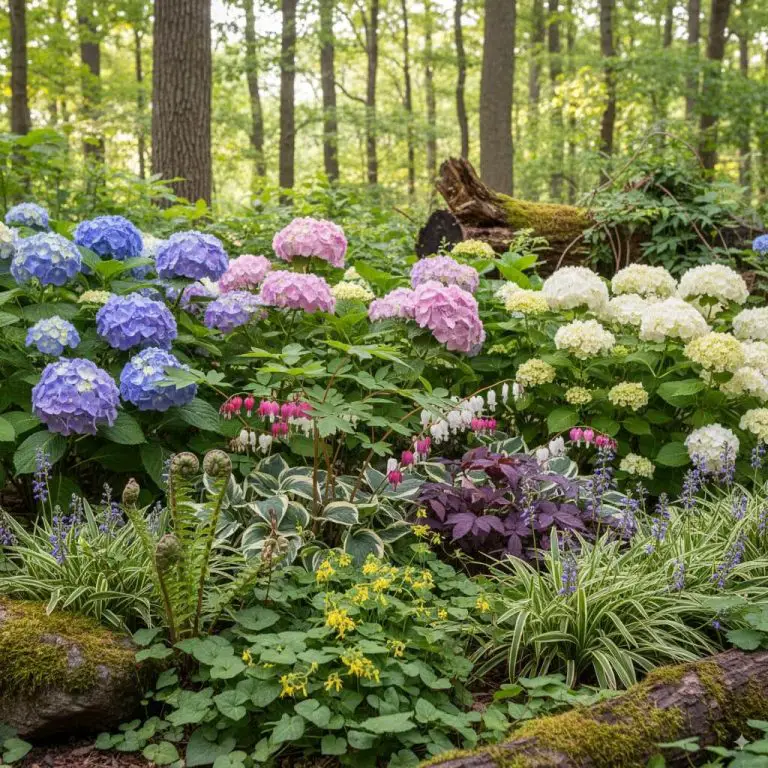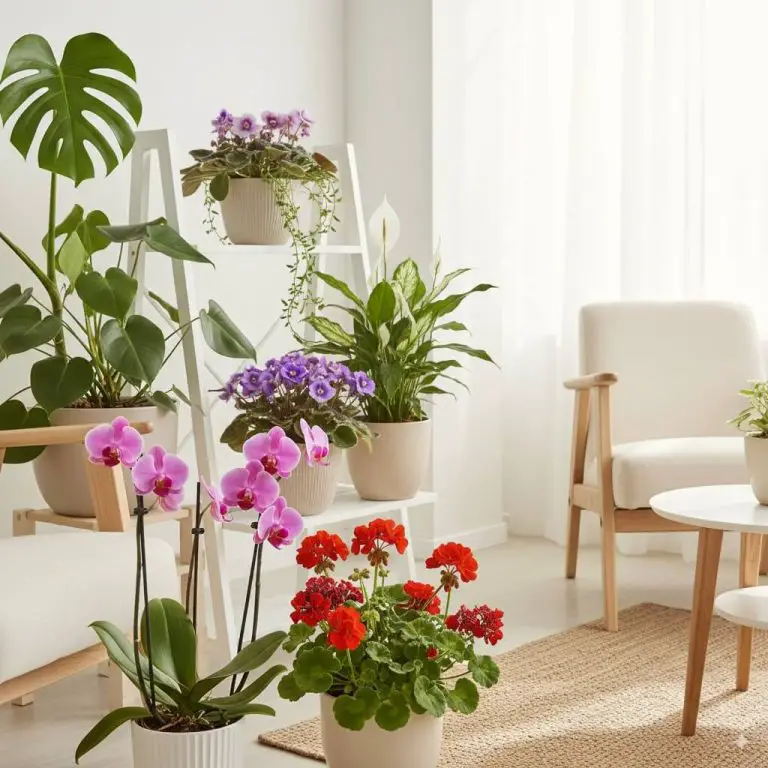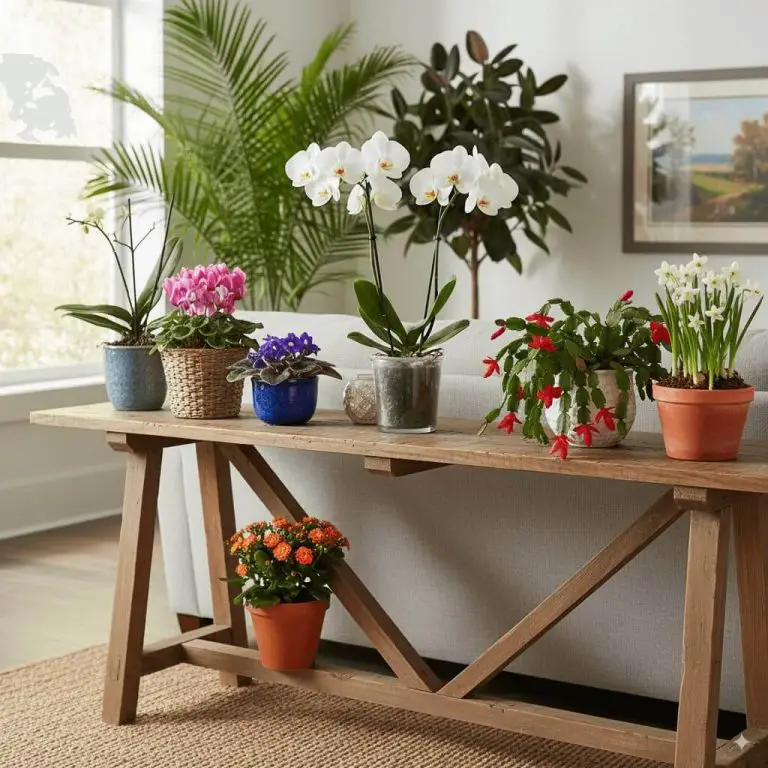Morning Sun Flowering Plants – A Complete Guide To Vibrant
Do you have that one spot in your garden? You know the one. It’s bathed in beautiful, gentle light as you sip your morning coffee, but by afternoon, it’s cast in cool, welcoming shade. It can feel like a tricky puzzle, leaving you wondering which flowers could possibly thrive in such a specific condition.
If you’ve ever felt stumped by this “part-sun, part-shade” dilemma, I’m here to tell you a little secret: that spot is a gardener’s dream. It’s the perfect microclimate for a huge range of stunning morning sun flowering plants that might struggle elsewhere.
I promise, by the end of this guide, you’ll see that garden spot not as a problem, but as a golden opportunity. We’ll unlock its full potential together.
In this complete guide, we’ll walk through the incredible benefits of this lighting, explore a list of my absolute favorite flowers for the job, and share a comprehensive morning sun flowering plants care guide to ensure your garden is bursting with color all season long.
What's On the Page
- 1 Why Morning Sun is a Gardener’s Secret Weapon
- 2 Our Top 15 Picks for Morning Sun Flowering Plants
- 3 Your Complete Morning Sun Flowering Plants Care Guide
- 4 Solving Common Problems with Morning Sun Flowering Plants
- 5 Sustainable and Eco-Friendly Morning Sun Gardening
- 6 Frequently Asked Questions About Morning Sun Flowering Plants
- 7 Go Forth and Grow!
Why Morning Sun is a Gardener’s Secret Weapon
Before we dive into the plants, let’s talk about why this “east-facing” light is so special. Understanding the benefits of morning sun flowering plants will help you choose the right ones and care for them with confidence.

🌿 The Companion Planting & Gardening Book (eBook)
Bigger harvests, fewer pests — natural pairings & simple layouts. $2.40
Get – $2.40
🪴 The Pest-Free Indoor Garden (eBook)
DIY sprays & soil tips for bug-free houseplants. $1.99
Get – $1.99Think of it as the best of both worlds. The gentle morning sun provides enough light for photosynthesis—the process plants use to create food—without the harsh, scorching intensity of the afternoon sun. This is a huge advantage!
Here’s what makes this light so ideal:
- Reduced Plant Stress: The intense heat of the afternoon sun can cause plants to wilt, scorch their leaves, and drop their flowers. Morning sun is much gentler, keeping plants happier and healthier.
- Longer-Lasting Blooms: Because the flowers aren’t being baked by extreme heat, their delicate petals often last much longer. This means a more beautiful, prolonged display for you to enjoy.
- Vibrant, Rich Colors: Intense sunlight can sometimes wash out or fade the colors of flowers and foliage. The softer morning light helps preserve those deep, saturated hues we all love.
- Moisture Retention: The soil in these spots doesn’t dry out as quickly, which means you’ll likely water less. This is fantastic for both water conservation and your busy schedule.
Our Top 15 Picks for Morning Sun Flowering Plants
Ready for the fun part? Here is a curated list of reliable, beautiful, and vibrant plants that absolutely adore a spot with morning sun and afternoon shade. I’ve grown many of these in my own garden and can personally vouch for their performance. Don’t worry—there are options here for every skill level!
1. Hydrangea (Hydrangea macrophylla)
The undisputed queen of the part-shade garden! Hydrangeas produce enormous, show-stopping blooms in shades of blue, pink, purple, and white. The afternoon shade is essential to prevent their large leaves from wilting dramatically.
2. Impatiens (Impatiens walleriana)
A classic for a reason. Impatiens provide a massive punch of color in a low-growing, mounding habit. They are the perfect annual for filling in borders or containers in a spot that gets a few hours of gentle sun.
3. Begonia (Begonia spp.)
Whether you choose them for their waxy, colorful flowers or their incredibly ornate foliage, begonias are a fantastic choice. They thrive in the consistent moisture and protection from harsh sun that a morning-sun spot provides.
4. Astilbe (Astilbe spp.)
If you want to add soft texture and height, look no further than Astilbe. Their feathery, plume-like flowers in shades of pink, red, and white look almost ethereal. They love moist soil and will thank you for the afternoon shade.
5. Coral Bells (Heuchera)
While known primarily for their stunning foliage that comes in every color from lime green to deep burgundy, Coral Bells also send up delicate, airy flower spikes. Too much sun can scorch their beautiful leaves, making morning sun their ideal home.
6. Bleeding Heart (Dicentra spectabilis)
A true springtime showstopper! The unique, heart-shaped flowers dangling from arching stems are unforgettable. This woodland native thrives in cooler, shadier conditions and is perfect for a morning-sun location.
7. Hosta (Hosta spp.)
Like Coral Bells, Hostas are foliage all-stars. But don’t discount their flowers! In mid-summer, they send up elegant spikes of trumpet-shaped blooms, often in lavender or white, that are beloved by hummingbirds. Morning sun helps bring out the best colors in variegated varieties.
8. Foxglove (Digitalis purpurea)
For dramatic, vertical interest, Foxglove is unmatched. Their tall spires are covered in beautiful, bell-shaped flowers. They are a classic cottage garden plant that prefers to be shielded from the hot afternoon sun.
9. Japanese Anemone (Anemone hupehensis)
Just when other flowers are starting to fade, the Japanese Anemone steps into the spotlight. These elegant, poppy-like flowers on tall, wiry stems provide graceful color in late summer and fall.
10. Fuchsia (Fuchsia spp.)
With their exotic, dangling, two-toned flowers, Fuchsias are a must-have for hanging baskets and containers. They are notoriously intolerant of intense heat, so a spot with morning sun and afternoon shade is non-negotiable for them.
11. Lobelia (Lobelia erinus)
This low-growing, trailing annual is perfect for spilling over the edges of pots, window boxes, and retaining walls. Its masses of tiny flowers, most famously in a brilliant true blue, appreciate a break from the afternoon heat.
12. Coleus (Plectranthus scutellarioides)
The foliage of Coleus is so vibrant and patterned it looks hand-painted. While newer varieties are more sun-tolerant, most still look their absolute best when protected from the harsh afternoon rays that can fade their spectacular colors.
13. Forget-Me-Not (Myosotis sylvatica)
These charming little plants create a carpet of tiny, sky-blue flowers in the spring. They are a delightful, self-seeding addition to any woodland-style garden that gets gentle morning light.
14. Toad Lily (Tricyrtis hirta)
If you want something truly unique, try the Toad Lily. Its small, orchid-like flowers are speckled with intricate patterns and appear in the fall. This is a true shade lover that can handle a little morning sun to fuel its bloom.
15. Rhododendron & Azalea (Rhododendron spp.)
These classic spring-blooming shrubs are a cornerstone of many gardens. They set their flower buds in the summer, and the protection from afternoon sun helps prevent the plant from getting stressed, ensuring a spectacular show the following year.
Your Complete Morning Sun Flowering Plants Care Guide
Success is about more than just picking the right plant; it’s about giving it the right care. This morning sun flowering plants care guide provides the best practices to help your garden flourish. Knowing how to care for morning sun flowering plants is simple once you master these basics.
Watering Wisely
The golden rule is to water in the morning. This allows the water to soak deep into the soil and be absorbed by the roots before the sun gets strong. It also ensures the foliage dries quickly, which helps prevent fungal diseases like powdery mildew. Always check the soil first—stick your finger in about two inches deep. If it’s dry, it’s time to water.
The Right Soil Foundation
Most of these plants prefer consistently moist but well-draining soil. Heavy clay soil that stays soggy can lead to root rot. Before planting, amend your garden bed with plenty of organic matter like compost or well-rotted manure. This improves both drainage and moisture retention—a win-win!
Fertilizing for Abundant Blooms
A slow-release, balanced fertilizer applied in the spring is often all these plants need. You can also supplement with a liquid feed every few weeks during the peak growing season. A pro tip: Avoid fertilizers that are too high in nitrogen, as this can lead to lush green leaves but very few flowers.
Pruning and Deadheading
Deadheading, or removing spent flowers, is the secret to encouraging many annuals and perennials to produce more blooms. It redirects the plant’s energy from making seeds to making more flowers. Pruning is generally done in early spring or after flowering (depending on the plant) to maintain shape and remove any dead or damaged branches.
Solving Common Problems with Morning Sun Flowering Plants
Even in this ideal location, you might encounter a few hiccups. Don’t worry! Here’s a look at some common problems with morning sun flowering plants and how to easily solve them.
Problem: Wilting in the Afternoon
Sometimes, even with afternoon shade, a plant with large leaves (like a hydrangea) will wilt on a very hot day. This is often just temporary heat stress. Check the soil—if it’s moist, the plant should perk back up as temperatures cool in the evening. If the soil is dry, give it a deep, slow watering at the base.
Problem: Powdery Mildew
This common fungal disease looks like a white, powdery coating on leaves. It thrives in humid conditions with poor air circulation. To prevent it, give your plants proper spacing when you plant them. If you see it, remove the most affected leaves and ensure you’re watering the soil, not the foliage.
Problem: Leggy Growth or Few Flowers
If your plant is getting tall and spindly with few blooms, it might not be getting enough morning sun. “Morning sun” can mean anything from 3 to 6 hours. If your plants are struggling, they may need a spot that gets closer to 5 or 6 hours of direct morning light.
Problem: Pest Patrol
Moist, shady areas can be a haven for slugs and snails, which love to munch on tender leaves, especially hostas. There are many eco-friendly solutions, from beer traps to diatomaceous earth sprinkled around the base of plants, that can keep them at bay.
Sustainable and Eco-Friendly Morning Sun Gardening
Creating a beautiful garden can and should go hand-in-hand with caring for our environment. Embracing sustainable morning sun flowering plants practices is not only good for the planet but also creates a healthier, more resilient garden.
Here are a few eco-friendly morning sun flowering plants tips:
- Choose Native Plants: Incorporate plants native to your region. They are adapted to your local climate and soil and provide essential food and habitat for local pollinators.
- Conserve Water with Mulch: Apply a 2-3 inch layer of organic mulch (like shredded bark or compost) around your plants. This is a game-changer for retaining soil moisture, suppressing weeds, and keeping roots cool.
- Make Your Own Compost: Turn your kitchen scraps and yard waste into “black gold.” Compost is the single best soil amendment you can use to build healthy, living soil that your plants will love.
Frequently Asked Questions About Morning Sun Flowering Plants
Q: What exactly does “morning sun” mean in gardening?
A: Generally, “morning sun” refers to a location that receives approximately 4 to 6 hours of direct sunlight in the morning, typically between sunrise and early afternoon. The key is that it is shaded during the hottest part of the day, from about 2 PM onwards.
Q: Can I grow vegetables in a morning sun spot?
A: Yes, you can! While sun-loving vegetables like tomatoes and peppers need full sun, many others do very well with morning sun. Leafy greens like lettuce, spinach, and kale, as well as root vegetables like carrots and radishes, often prefer the break from the intense afternoon heat.
Q: My “morning sun” spot is under a large tree. What should I consider?
A: The main challenge under a tree is not just light, but also root competition and dry soil. The tree’s roots will compete for water and nutrients. You’ll need to amend the soil with extra compost and be diligent about watering. Choose plants known for thriving in “dry shade” conditions.
Q: How do I know if my plants are getting too much sun, even if it’s just in the morning?
A: Look for signs of stress. The most common indicators are scorched or crispy leaf edges, faded or bleached-looking foliage, and persistent wilting even when the soil is moist. If you see these signs, your plant may need a spot with even less direct sun.
Go Forth and Grow!
That once-tricky garden spot is now a canvas of possibilities. You’re armed with the knowledge to transform it into a lush, vibrant oasis filled with happy, thriving flowers. The key is simply to work with the light you have, not against it.
Remember the simple principles from this morning sun flowering plants guide: choose the right plant for the right place, build a foundation of healthy soil, and water wisely. By following these steps, you’re well on your way to creating a stunning garden that brings you joy every single day.
Now, grab your gloves and a trowel—your beautiful morning-sun garden is waiting. Happy planting!
- Insecticidal Super Soap – Your Ultimate Guide To Eco-Friendly Pest - December 12, 2025
- What Can Happen If You Eat Mold – A Gardener’S Guide To Food Safety & - December 12, 2025
- Nutrients And Plant Growth – Unlock Your Garden’S Full Potential With - December 12, 2025



